Mediating American autobiography : photography in Emerson, Thoreau, Douglass, and Whitman /
| Author / Creator: | Meehan, Sean Ross, 1969- |
|---|---|
| Imprint: | Columbia : University of Missouri Press, c2008. |
| Description: | xi, 250 p. : ill. ; 24 cm. |
| Language: | English |
| Subject: | |
| Format: | Print Book |
| URL for this record: | http://pi.lib.uchicago.edu/1001/cat/bib/7133370 |
| Summary: | The emergence of photography in the mid-nineteenth century transformed ideas about how the self and nature could be pictured. Although the autobiographical potential of photography seems self-evident today, Sean Meehan takes us back to the birth of the medium when some of America's preeminent authors began to think about photography's implications for the representation of identity and the nature of autobiographical writing. Both photography and autobiography involve a tension between disclosing and concealing their means of production: a chemical process for one, the writing process for the other. Meehan examines how four major authors--Ralph Waldo Emerson, Henry David Thoreau, Frederick Douglass, and Walt Whitman--were well aware of this tension and explored it in their work. By examining the implications of early photography in their writings, he shows how each engaged the new visual medium, how photography mediated their conceptions of self-representation, and how their appropriation of photographic thinking created a new kind of autobiography. Examining the metonymic nature of photography, Meehan explores how the new medium influenced conceptions of visual and verbal representation. He intertwines these four writers' reflections on photography--in Emerson's Representative Men , Thoreau's journals, Douglass's narratives of slavery, and Whitman's Specimen Days --with theories of photography as expounded by its inventors and observers, from Louis Daguerre and William Talbot in Europe to Oliver Wendell Holmes and Marcus Root in America. As the first book to focus on the emergence of this new visual medium during the American Renaissance, Mediating American Autobiography shows us what photography means for American literature in general and for the genre most closely linked to it in particular. Because the engagement of these writers with photography has been neglected in previous scholarship, Meehan's work provocatively bridges the study of two media and illuminates an important aspect of American thought and culture at the dawn of the technological era. |
|---|---|
| Physical Description: | xi, 250 p. : ill. ; 24 cm. |
| Bibliography: | Includes bibliographical references (p. 227-238) and index. |
| ISBN: | 9780826217929 0826217923 |

